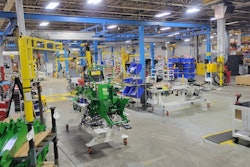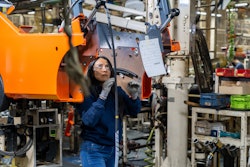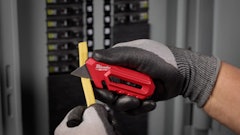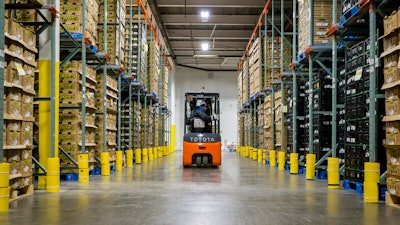
According to a recent forecast by the American Rental Association (ARA), the rental equipment industry is on track for growth for the remainder of this year and well into 2022. Updated second quarter forecasts released by the ARA project equipment rental revenue to exceed $47.8 billion in 2021, a nearly 3.5 percent increase over 2020. And while an upward trend in the industry is good news, that momentum amplifies the importance of having efficient processes in place to capitalize on that growth.
In Rental's June issue, in the article, “What is Lean Management and How Can it Optimize Your Rental Business?” I introduced Toyota Lean Management (TLM) and explained how lean principles can improve your rental business by eliminating waste and maximizing productivity. There will always be external factors that impact your business as the world evolves, but one way to limit the impact of those factors is a strong framework like Toyota Lean Management.
So, what is Toyota Lean Management exactly? Put in its most simple form, lean management is about eliminating waste without sacrificing productivity to improve work processes, purposes, stakeholder value, and bottom lines. This is done in three ways: delivering value from your customer's perspective, eliminating things that don't bring value to the end product (i.e. waste), and continuous improvement.
The entire concept of lean management is derived from the world-renowned Toyota Production System (TPS), established over 70 years ago. At the core of TPS and TLM is process standardization, continuous improvement, and waste elimination. In a rental business, waste can take the form of:
- Defects
- Waiting time
- Extra motion
- Excess inventory
- Extra processing
- Unnecessary transportation
- Over-production
The Foundation of Lean Management - 5S Systematize
The foundation of Toyota Lean Management is 5S, a set of principles that can be applied to any operation to help improve organization, efficiency, and overall productivity.
The 5S process was coined and made popular by Toyota, and is based on five disciplines starting with the letter “S.” Those are, in Japanese, Seiri (Sort), Seiton (Systematize), Seiso (Shine), Seiketsu (Standardize), and Shitsuke (Sustain).
The 5S concept might sound a little abstract, but in practice, it's a hands-on tool that everyone in the rental industry can be a part of. We’ve all encountered disorganized work areas where clutter or interrupted workflow created wasted time, resulted in unnecessary spending or impacted productivity. Practicing 5S involves assessing everything present in a space, removing what's unnecessary, organizing things logically, performing housekeeping tasks, and keeping this cycle going. Organize, clean, repeat.
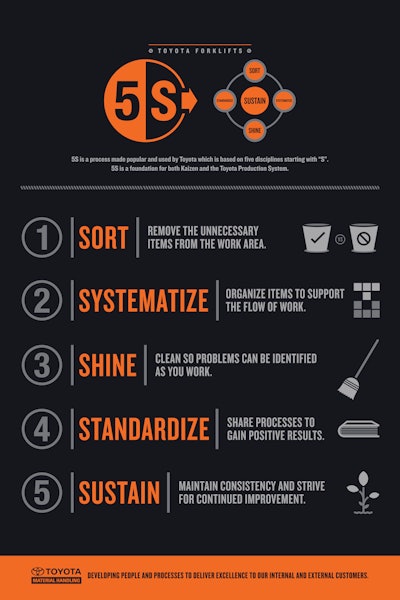
1 – Seiri – SORT
The first stage of 5S is to sort. This means going through items and deciding what is necessary and what is not to reduce clutter. Eliminating unnecessary items may be difficult, but it’s important to maximize space and efficiency. If it doesn’t add value, get rid of it.
Sorting also forces you to think about how items are regularly used during the work day. If you are unsure about a certain item, it can be useful to create an “unknown category” and track the item’s use during a week or a month to determine if the item is necessary in that particular space. If the items aren’t used in your specified time period, they are unnecessary. You might be surprised just how many unnecessary items in your workplace can lead to productivity inefficiencies. Some questions to ask during this phase include:
- What is the purpose of this item?
- When was this item last used?
- How frequently is it used?
- Who uses it?
- Does it really need to be here?
Keep in mind the best people to assess the items in a space are the people who work in that space. They are the ones who can best answer the above questions.
2 - Seiton – SYSTEMATIZE
After eliminating clutter or unneeded items in a space, you can move to the step of straightening and systematizing, sometimes referred to as “set in order.”
This literally means creating a system for a particular space. At Toyota, we like to say, "There’s a place for everything and everything has its place." Labeling spaces with the name and number of items helps to systematize your storage.
During this step, it’s beneficial to think of the flow of a workspace by asking these questions:
- What items get used the most and at what time?
- Who enters and exits this space?
- What is the intended purpose of this space?
3. Seiso – SHINE
Systematizing a workplace creates a space for everything, and shining helps to refine the space and system. While shine does refer to cleaning and tidying items, this step also includes fixing problems. As you are cleaning a space, you may notice inconsistencies or a general lack of organization. In this step, you should address those issues, make necessary changes, and implement countermeasures as you go.
4. Seiketsu –STANDARDIZE
This step is about creating successful practices to efficiently complete a process or task that can be duplicated to optimize productivity and eliminate waste. Standardization allows the process to be easily shared among team members. Completing a process or task in the same efficient way each time allows you to identify and address systematic breakdowns to ensure a consistent, high-quality result.
Many managers find it helpful to develop rules to ensure employees duplicate optimized processes and develop new “standardized” habits. The standardized processes can be shared with anyone on your team and can be used to onboard new employees more effectively. Standardizing means:
- Dividing tasks into simple steps
- Performing the steps in the same way each and every time
- Providing the items necessary to successfully and efficiently complete the process every time
For example, in a maintenance shop setting, the standard process may call for “a maximum 20 cases of hydraulic fluid, minimum five cases.” In this example, the written standardized rule holds anyone who opens the fifth remaining case of hydraulic fluid accountable for replenishing the supply.
5. Shitsuke – SUSTAIN
The last step in the 5S process is truly never-ending. Sustaining is the most important step and the most difficult part of the 5S process. To sustain, you must implement a culture based on the concept of “kaizen,” or continuous improvement. Just because a process or rule is in place doesn’t mean that it can’t be improved or evolved over time. Every person in your organization must be committed to looking for ways to improve processes every day to successfully sustain 5S.
Keeping up with and sustaining a productive and efficient space means that the 5S process never stops. The only way to sustain 5S requires some kind of regular audit to ensure all of the principles are being practiced correctly.
Some ways to make "Sustaining" a habit:
- Look for waste – empower and encourage employees to be active participants in this
- Visualize the work area and look for deviations
- Look for the root cause of every problem that arises
- Develop standards
- Repeat the process
Your Lean Journey is Ongoing
While implementing 5S may seem like a one-time task, it must be practiced every day to add the most value to your organization. And getting employee involvement is key. When your employees are in the habit of practicing the principles in the workplace, it’s easier for them to navigate, find what they need, and keep things organized. It makes it easier for them to do their jobs and do them at a high level. The five disciplines are designed to improve efficiency, reduce waste, and free up personnel to concentrate on other more productive, less repetitive tasks, resulting in increased productivity for your rental business.
The 5S system can be explored in depth in this video. In the next part of this series, we will examine how additional Toyota Lean Management processes can be implemented in your rental company to improve efficiency, productivity, and the bottom line.




